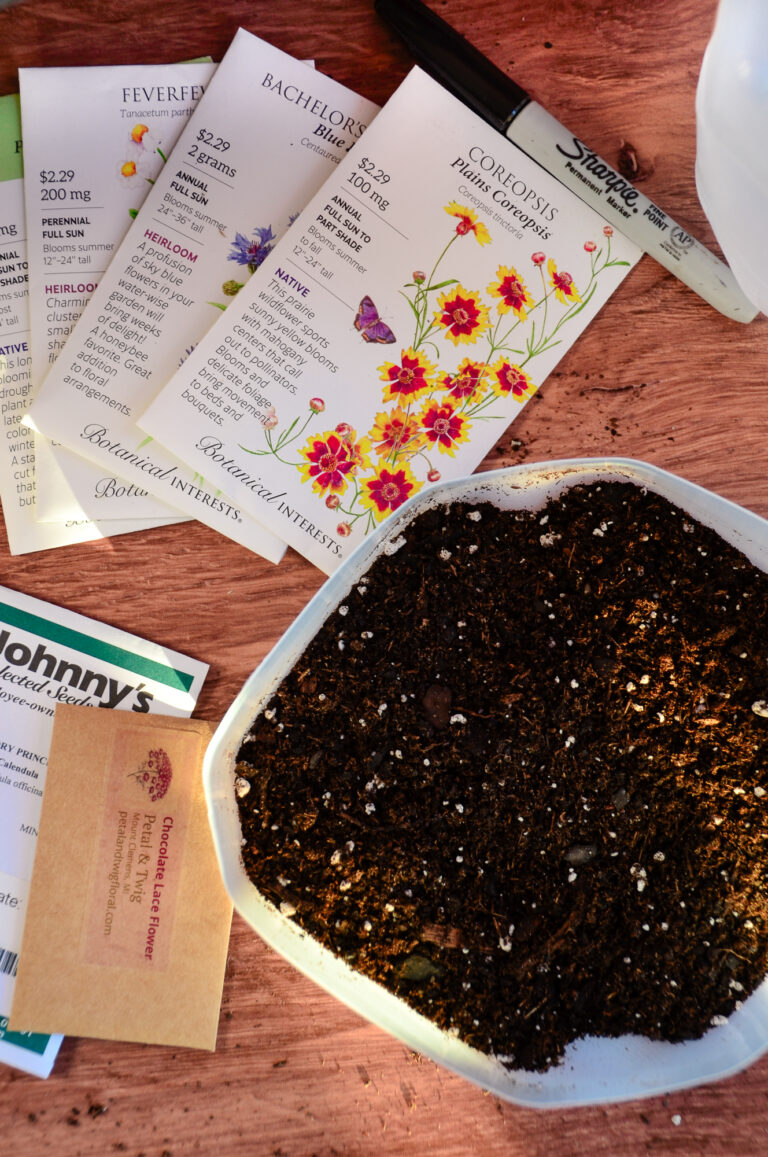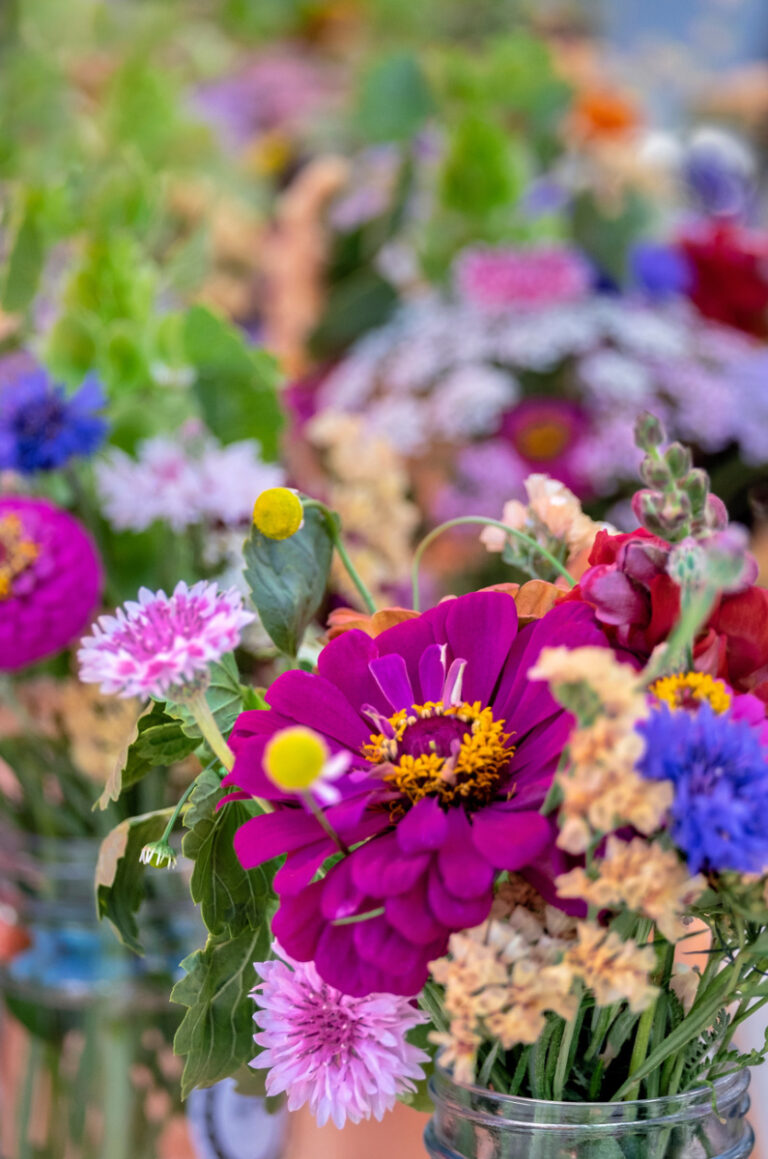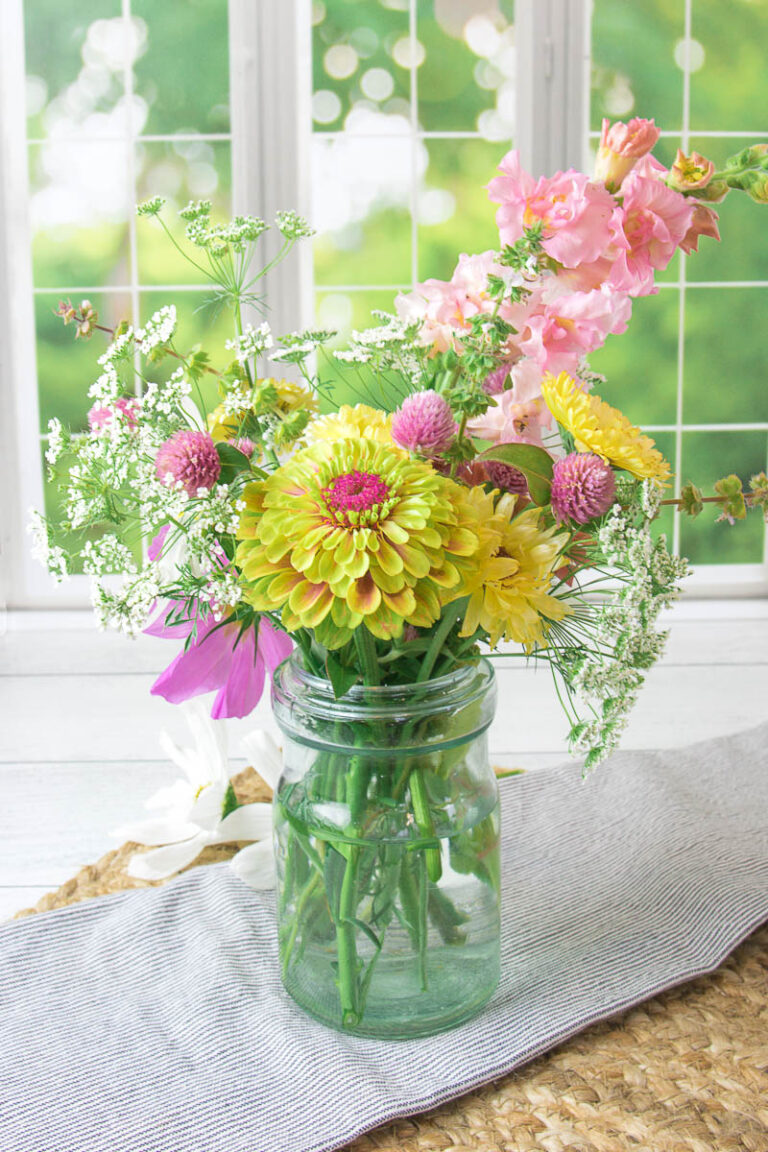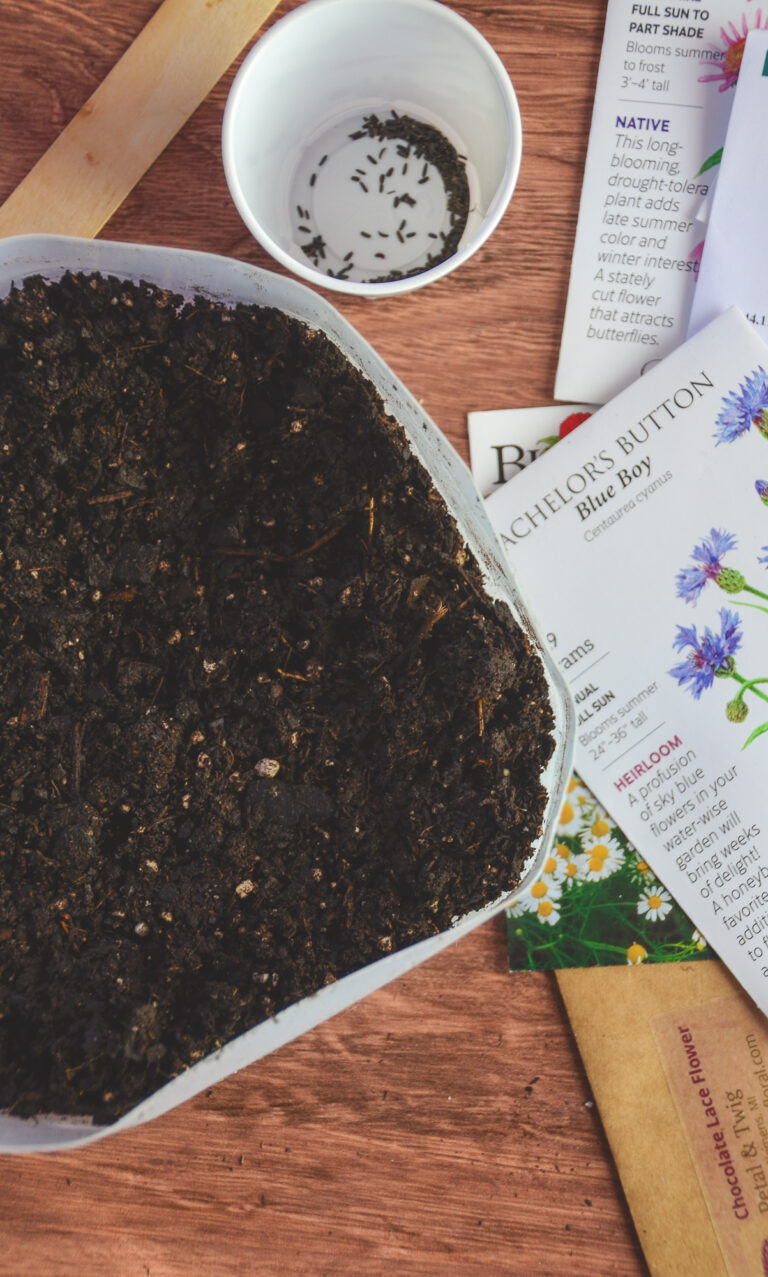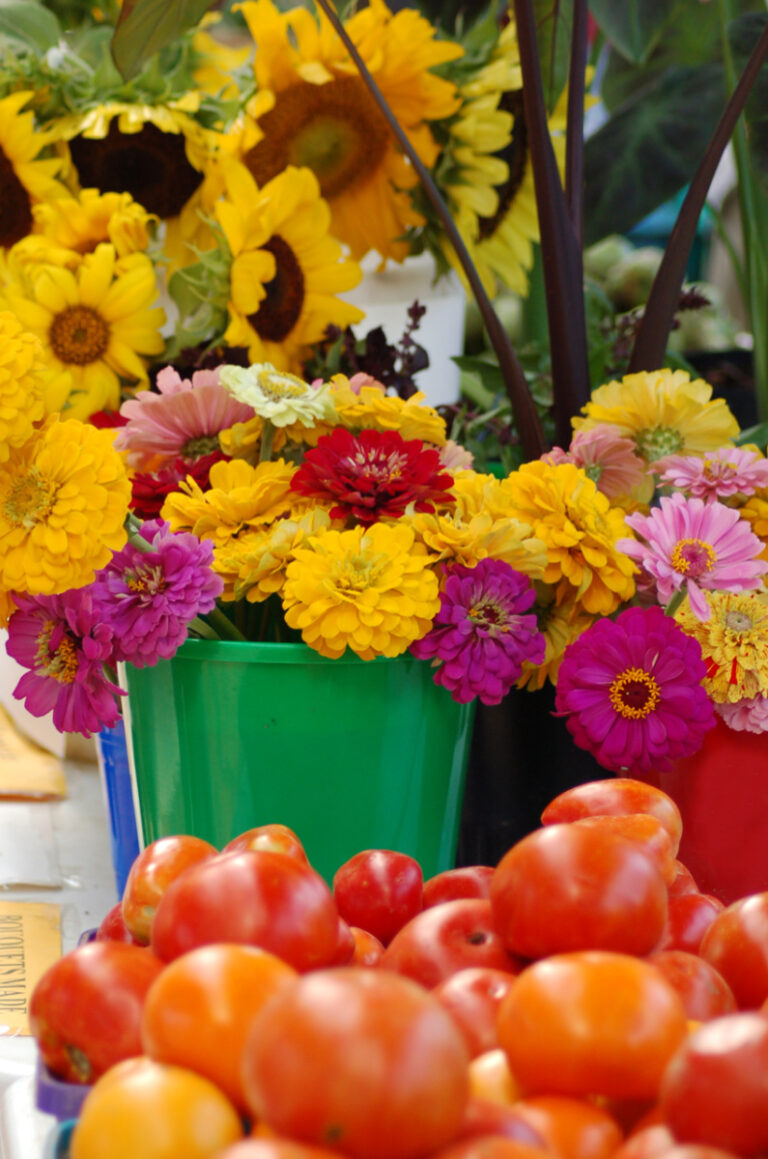Selecting Seeds For Winter Sowing
Get a head start on your garden with winter sowing and our guide on the best flowers, herbs, and vegetables to start during the colder months.
After the holiday’s is the perfect time to plan and begin your winter sowing. This method of seed starting gives you head start on the growing season, allowing hardy plants to establish themselves even in the colder months. Winter sowing involves planting seeds in mini greenhouses outdoors, where they naturally acclimate to the conditions.
Winter sowing is ideal for a variety of plants, and in this post, we will explore an array of flowers, herbs, and vegetables that thrive through winter sowing. From the vivid blooms of poppies and the robust flavors of parsley, to the nutritious greens of kale and lettuce, each selection is tailored to maximize your garden’s potential even in the chill of winter.

Flowers
Native and wildflowers are my favorite seeds to winter sow. Since I often start a multitude of vegetable seeds indoors during the traditional seed-starting season for our market garden, space can become very limited. By winter sowing my flower seeds, I ensure that my garden will have beautiful blooms I crave, without occupying precious space under grow lights. This method allows me to enjoy the best of both worlds – a vibrant array of vegetables nurtured indoors and stunning wildflowers that begin their journey outdoors mid-winter.
- Poppies: These are hardy annuals known for their vibrant, delicate petals. Ideal for winter sowing, they bloom in a variety of colors including red, pink, and orange.
- Coneflowers (Echinacea): These perennials are known for their large, daisy-like flowers with raised centers. They come in colors like pink, purple, and white, and are popular for their medicinal properties.
- Black-Eyed Susan (Rudbeckia): A hardy perennial that blooms in the first year, these flowers feature a prominent, dark brown center surrounded by yellow petals.
- Sweet Peas: Prized for their fragrant, colorful blooms, sweet peas are climbing annuals that thrive in cooler temperatures.
- Lupines: Known for their tall, spike-like clusters of flowers, lupines come in a range of colors and are great for adding height to gardens.
- Sunflowers: Hardy and able to handle cold temperatures, sunflowers are distinguished by their large, round flower heads and their ability to follow the sun.
- Calendula: Often known as pot marigold, these annuals are easy to grow and come in shades of yellow and orange. They are also known for their medicinal and culinary uses.
- Celosia: With their unique, flame-like flower heads, celosia comes in bright shades of red, orange, and yellow. They are annuals that prefer warm weather.
- Cosmos: These annuals are known for their daisy-like flowers and feathery foliage. They come in a variety of colors and are easy to grow.
- Lavatera: Resembling hollyhocks, lavatera are annuals or perennials with large, showy blooms in shades of pink and white.
- Marigold: These annuals are popular for their bright orange and yellow flowers. They are easy to grow and often used in gardens for pest control.
- Morning Glory: Known for their trumpet-shaped flowers and heart-shaped leaves, these annual vines prefer full sun and provide a burst of color.
- Petunia: These popular annuals come in a wide range of bright colors and patterns. They are great for hanging baskets and containers.
- Snapdragon: Recognized for their tall, spiked flowers that open and close like a dragon’s mouth, snapdragons come in a variety of colors and are cool-season annuals.
Herbs
Herbs are an exceptional group of plants that can greatly benefit from winter sowing. This method is particularly ideal for hardy herbs like parsley, cilantro, and dill, which can endure cooler temperatures and even thrive when exposed to the natural elements early on. Winter sowing these herbs not only frees up indoor space but also aligns their growth cycle with the natural outdoor conditions, resulting in stronger, more resilient plants.
- Parsley: A biennial herb known for its curly or flat leaves, parsley is good for early sowing and widely used in culinary dishes for its fresh, slightly peppery flavor.
- Cilantro: This annual herb tolerates cool temperatures and can be sown in early spring or late winter. Known for its distinctive, fresh taste, it’s a staple in various cuisines.
- Dill: Able to handle frost, dill is suitable for winter sowing. It’s an annual herb with feathery leaves and is widely used for its fragrant seeds and foliage in cooking.
- Chives: A hardy perennial, good for early sowing. Regular chives have a mild onion flavor, while garlic chives offer a gentle garlic taste. Both are great for culinary uses.
- Sage: This perennial herb benefits from winter sowing. It has a strong, slightly peppery flavor and is commonly used in a variety of culinary dishes.
- Anise Hyssop: A perennial herb with a licorice-like flavor, it’s valued for its fragrant leaves and attractive purple flowers.
- Lavender: Known for its fragrant purple flowers, lavender is a perennial herb used in both culinary and aromatic applications.
- Mustard: This annual herb is grown for its seeds and leaves, which are used in cooking for their spicy, peppery flavor.
- Oregano: A staple in Mediterranean cuisine, oregano is a perennial herb with a pungent, earthy flavor. It’s used extensively in cooking, especially in Italian dishes.
- Peppermint: A hardy perennial herb known for its strong, refreshing aroma and flavor. It’s widely used in teas, culinary recipes, and for its medicinal properties.
- Salsify: This biennial vegetable herb is grown for its edible root, which has a mild, oyster-like flavor. It’s used in soups and stews.
- Summer Savory: An annual herb with a peppery flavor, summer savory is used in a variety of dishes, particularly in bean recipes.
- Chamomile: Known for its daisy-like flowers and apple-like aroma, chamomile is a perennial herb used primarily in herbal teas for its calming properties.
Vegetables
Winter sowing is remarkably effective for a wide range of vegetables, particularly those that flourish in cooler climates. Vegetables like lettuce, spinach, peas, and broccoli are excellent candidates for this method. By sowing these seeds in the tranquility of winter, they undergo natural stratification, resulting in vigorous and hearty plants ready to spring to life at the first signs of warmer weather.
- Lettuce: A cool-weather crop ideal for early sowing. Comes in a variety of forms and is a staple in salads due to its crisp texture and mild flavor.
- Kale: A hardy leafy green that can be sown early. Known for its nutritional value and versatile use in cooking, from salads to chips.
- Spinach: This leafy green tolerates frost and is suitable for winter sowing. It’s a versatile vegetable, rich in iron and vitamins, used in salads, soups, and sautéed dishes.
- Peas: Hardy and can be sown as soon as the ground can be worked. They are grown for their sweet, edible pods or seeds and used in a variety of dishes.
- Broccoli: A hardy vegetable good for early spring or late winter sowing. Known for its dense green flower heads and stalk, it’s a popular and nutritious vegetable.
- Arugula: A peppery, leafy green often used in salads. It grows quickly and prefers cooler weather.
- Brussels Sprouts: These resemble miniature cabbages and are sown in early spring for a fall harvest. They have a nutty, slightly bitter taste and are rich in nutrients.
- Cabbage: This leafy green is known for its dense, round heads. It’s versatile in the kitchen, used in everything from salads to sauerkraut.
- Cauliflower: Similar to broccoli but with a white, dense flower head. It’s versatile in cooking, used in dishes ranging from raw salads to mashed cauliflower.
- Collard Greens: A hardy leafy green, collards are known for their large, dark green leaves and slightly bitter taste. Commonly used in Southern U.S. cuisine.
- Endive: A leafy vegetable with a slightly bitter flavor, often used in salads and as a garnish.
- Leeks: Resembling large scallions, leeks have a mild onion-like flavor and are used in a variety of dishes, from soups to sautés.
- Radicchio: Known for its red and white leaves and bitter and spicy taste, radicchio is often used in salads and as a grilled or roasted dish.
- Swiss Chard: A leafy green with brightly colored stems. Its leaves have a slightly bitter taste and can be used similarly to spinach or kale.
- Kohlrabi: A bulbous vegetable with a taste and texture similar to a broccoli stem or cabbage heart. It’s often eaten raw or cooked.
The seeds I’ve highlighted above, ranging from native flowers to hardy cool-weather vegetables, are perfectly suited to starting during the cooler weather, setting the stage for a bountiful and vibrant garden. Whether you’re a seasoned gardener or a budding green thumb, winter sowing offers a rewarding and efficient way to kickstart your garden.
Id love to hear about your winter sowing favorites. Whether it’s a flower that never fails, a must have herb, or a vegetable that thrives in your winter garden, your experiences and choices can inspire fellow gardeners. Share your top winter sowing picks in the comments below!


